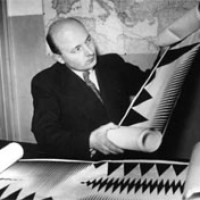Fischingerwas an abstract painter, animator and director of avant-garde films. He also learned how to repair organs. In 1922, he finished studying engineering in Frankfurt. As a student he was a member of a literature club. There he met the theatre critic Bernhard Diebold, who inspired him to start experimenting with film and also introduced him to the abstract film pioneer, Walther Ruttmann. Fischinger invented a machine that utilized wax for the creation of film pictures that he used himself and also sold to Ruttmann. In 1923, he moved to München and made several films, including
Spiritual Constructions (Seelische Konstruktionen, 1927). Because of business problems, in 1927, he moved to Berlin and made
München-Berlin Wanderung. In Berlin he worked for the film production house UFA and made special effects for films such as Lang’s
Girl in the Moon (Frau im Mond, 1928). He continued to make abstract films and paid close attention to the synchronization of music with shapes and movements of abstract forms in his films. His series of short films,
Study (Studie, 1930-1934), was especially successful. He managed to sell it in Europe, Japan and US. He was the first filmmaker who used the three-color system (called
gasparcolor after the Hungarian inventor Béla Gaspar) in an avant-garde film. His commercial
Circles (Kreise, 1933) the first film in color. In his time he was a successful director of commercials like
Muratti Marches On (Muratti greift ein, 1934); film commercials and political spots. His avant-garde film
Composition in Blue (Komposition in Blau, 1935) brought him critics’ and audience’s acclaim as well as an award at the Venice film festival. However, because of this film he had problems with German film censors (Nazis disapproved of abstract art and called it “degenerate”) and in 1936 moved to the US with his wife. He got a job in
Paramount studio but unfortunately did not develop his career mainly due to the language barrier and conflicts with American producers about his creative freedom. In the US he took up painting again and for some time received moderate financial help from the Guggenheim foundation. His oil paintings were displayed at many exhibitions and his earlier avant-garde films shown in retrospectives around Europe and the US. Aside from a few commercials, he did not make any films from 1947 until his death in 1967.

